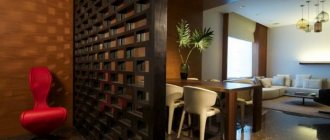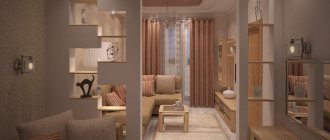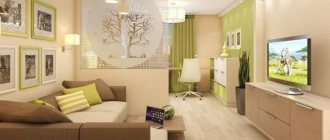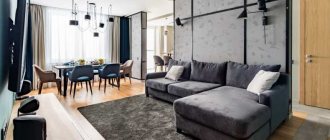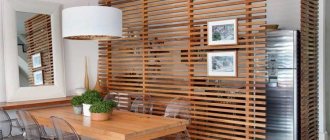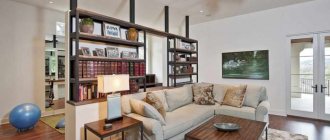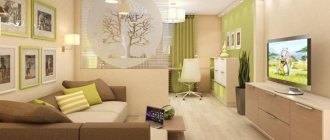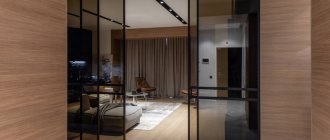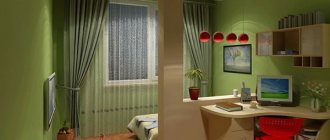Decorative screens are considered a classic attribute of interiors. They are intended for visual zoning of space, and also perform an aesthetic function. Modern models are made in different variations and from different materials. Screens are used in any room of the apartment in accordance with the chosen interior style.
Types of screen partitions.
Structurally, screen partitions are divided into casement, roller and screen. Each type has its own characteristics and purpose.
Folding (folding). Classic, the most popular screen option. The design consists of a rigid frame and segments-leafs, folds like an accordion. Stable and suitable for any room. Compact - shrinks to fit into limited space.
A model with sections of different sizes looks unusual.
Screen. One-piece vertical canvas. It is made of plastic and canvas, so it can be moved easily. The disadvantage of the screen-panel is the lack of compactness. The partition does not fold or roll up.
Interior partitions are created using a solid wooden frame filled with dense textiles, bamboo, rattan or similar materials.
Glass screen partitions are appropriate for the bathroom, kitchen, and other rooms that require increased cleanliness.
Screens are mounted on bracket supports or legs and are equipped with wheels.
Flexible. Technological, stylish and functional look. It consists of elastically connected strips that visually imitate a solid fabric. Easily rolls into different shapes.
It is usually made of light plastic, creating space and airiness. Suitable for modern style rooms.
Screen shelf. The function of the screen is double: zoning the room plus storing small things that always get lost.
Pockets and shelves also contain beautiful little things, books, photos, and stationery.
Scope of application of stationary classic screens
Stationary interior partitions have a lot of options for use both in small apartments and in large private houses. For example, using beautiful screens to divide the space between the bedroom and bathroom is quite common in design. This partition allows you to place a sink on the bathroom side, as well as hang a picture or TV, or make open shelves for books or small items on the bedroom side with screens.
A similar version of combined partitions allows you to create a whole range of storage systems, placing a video zone on one side and a desk on the other. This design would be appropriate in a living room with a home office located there.
Using fixed partitions in a large living space helps separate the dining room or library. As a result, you can achieve the desired privacy of certain functional segments of the house using small screens.
The same goes for separating the dining room from the living room. Glass partitions do not block the penetration of light, but create an intimate atmosphere.
Decorative “openwork” partitions or lace screens separating the living room from the dining room do not prevent the penetration of natural light. They add a unique touch to the interior, but at the same time fulfill their main function of zoning space.
A similar partition can be used as a zoning element for spacious utilitarian rooms. In this case, you need to be sure that the material has relatively high water-resistant qualities.
In a one-room studio apartment it is very difficult to do without partitions. Classic-style screens made of light wood are perfect for highlighting the sleeping segment, while the material should actively participate in the manufacture of furniture and even decor.
Some types of stationary partitions are created not only for the purpose of zoning, but also as holders. Most often, these structures are used to fix TV and other video and audio equipment.
The invaluable advantages of the screen.
Screens of all designs, especially folding ones, are indispensable for one-room housing and useful in spacious ones. Performs several functions.
- Zoning. This is a simple tool for dividing space into zones. Without erecting permanent walls or inviting craftsmen to install suspended structures, a personal area, places for changing clothes, and a guest space are created in one room. Spacious rooms become more comfortable.
- Aesthetics. The screen decorates the room. You just need to coordinate the style of sliding or straight structures and the interior. In rooms with massive furniture, a fragile screen or curtain makes the atmosphere lighter.
- Practicality. The partition is mobile and can be easily moved to a new location. It can be removed or restored. When folded, the sliding screen is compact - a pantry or balcony is enough for storage.
- Versatility. Screen partitions are very convenient because they replace other, often bulky, objects and things. The screen on or opposite the window serves as a curtain. A design with shelves or pockets looks more elegant than a bookcase or rack. A beautiful unusual partition fills an empty corner.
The decorative and functional nature of the screen makes it a useful and sometimes irreplaceable part of the interior.
Advantages of screens for zoning rooms
Despite the fact that screens “fell out of favor” for a long time and returned to our everyday life relatively recently, the benefits of their use should not be underestimated. Even without being an essential item and the main element of furniture, they can be a great help. A studio is not always a spacious room; modern economic realities are such that the majority of such premises are small in size. And where there is an acute shortage of square meters, a portable, and even folding partition, which, when stored, will take up a minimum of space, and when opened, will perfectly separate the desired area, will come in handy. The screen has a number of advantages:
- Availability - and ready-made ones cost quite adequately, and if you do it yourself, it will turn out even less, and certainly cannot be compared with the construction of even a lightweight frame partition.
- Mobility - installed anywhere, in any direction, takes any desired shape, depending on the number of sashes.
- Decorative - a huge selection of coatings, textures, stylistic and color solutions, for every taste and for any interior.
- Functionality - if you add removable shelves/pockets to the doors, it will also serve as a storage system for small items at hand. Some models may include a mirror on one of the doors; such screens are relevant as a dressing room.
There are three types of screens according to their configuration:
- Floor-mounted – stand directly on the bottom rail.
- With legs - either only at the edges, or on each sash.
- With wheels - wheels can be static or removable.
Screen partition design for a room.
The range of screen partitions allows you to choose an option that organically complements the decor of rooms of any style.
Living room.
The screen is made to match the color and style of the room: openwork metal, wood with luxurious textiles such as brocade or silk (for classics, romance), plastic (for hi-tech, techno, loft). An interesting solution is a mirror-glass model with inserts that repeat the pattern or color of the furniture glass.
Children's room.
A partition is necessary if the room is shared by children of different ages or genders. A design with pockets is indispensable in a newborn's room.
The partition is made of wood or environmentally friendly plastic or natural fabric.
It makes sense to use designs with fabric secured with ties - it can be easily removed for washing.
The design is determined by the age and interests of the owners:
- For kids, this is a screensaver with bright plastic screens depicting characters from fairy tales and cartoons. Also used as a puppet theater.
- Teenagers will like models with pockets, built-in shelves, and photo frames. When purchasing a screen, it is better to go with your child so as not to make a mistake in the theme.
- Parents sharing a room with a baby will benefit from a double-sided partition. On the one hand there is a bright children's plot, on the other - in the style of an “adult” room.
Attention! A screen (especially one with shelves) for a child’s room should be stable so as not to tip over from an accidental shock.
Bathroom.
The screen looks more presentable than conventional curtains. Transparent plastic or frosted or tinted tempered glass makes frameless structures airy and does not overload the space. They cover the window, create an area for changing clothes, and divide the spacious bathroom into two classic zones.
A useful model with pockets for accessories and hooks for towels and clothes.
Bedroom.
An elegant carved wooden (or rattan, bamboo) or plastic frame will do. Expensive textiles, soft tones, matching the color of curtains or wallpaper.
The changing corner is decorated with a mirror screen, behind which there is a chair or table and hooks for clothes.
Kitchen.
A screen made of moisture-resistant materials (plastic, tinted or stained glass) matching the color of the walls or furniture will turn one room into a kitchen and dining room.
No. 5. Light and mobile or durable and forever?
It's up to you to decide.
If you are a person with a very changeable mood, and it is common for you to change the interior of your apartment, or at least a room, almost every year, then a screen made of a welded metal frame that is attached to the floor and ceiling is unlikely to suit you. After all, installation and dismantling costs a lot of money, and you will receive an additional bonus in the form of holes in the floor and ceiling. Therefore, think for the last time and weigh the pros and cons, because no one knows you better than yourself! And may the screen you choose complement your interior exactly as you wanted and perform its functions to your delight! The article was written for the site.
Tags:Apartment design
Partition material.
The design is largely determined by the material from which the screen is made.
- Tree. Suitable for room partitions of all types. Wooden screens are especially suitable for allergy sufferers and children. A lightweight option is wicker screens made of bamboo, rattan, and willow. Calm shades accentuate the naturalness of the interior. Good for colonial and eco-style houses.
- Metal. The partition is decorated with filigree forging, including patination. Visually light, in reality metal decorative screens are heavy, so they are used as a stationary zoning element.
The legs are equipped with thrust bearings to prevent damage to the floor covering. Suitable for fireplace rooms in cottages and large apartments.
- Plastic. The curtain is inexpensive, light, practical. There are models on wheels. Ideal for kitchens, bathrooms, loft, youth, and high-tech living spaces. Stone or wood treatment will decorate classic, romantic and similar interiors
- Mirror, glass. It will fit into a boudoir, the home of bohemian people, or a formal living room. Not all doors may be mirrored; a duet with frosted, stained, or colored glass is interesting.
Attention! A screen-mirror “doubles” the space, so it is desirable for a small room. However, you need to not overdo it with things, the number of which will visually double.
Furniture zoning
Transforming blocks
These designs of dividing a room into two zones are a relatively new technique, but are just gaining popularity. Transformable furniture is created from separate blocks, the number of which can be changed at your discretion and moved around the room without spending much effort. By changing the location of the modules, you can get a variety of furnishings from a wardrobe to a cabinet.
Zoning with transforming blocks
Wardrobe
This bulky piece of furniture is akin to a wall partition. It stands monumentally and it will not be possible to quickly remove it if necessary. Otherwise, the solution is quite convenient. Dividing a room with a closet can be made as functional as possible. In this case, there should be a wardrobe in the bedroom area, and open shelves filled with cute little things or books in the living room. It should be taken into account that a closet, unlike a decorative screen or other kind of partition, will require a lot of space, so it is not advisable to use it in this role in a small room.
Functional division of a room with a wardrobe
Rack
This piece of furniture is less bulky than a cabinet and is more transparent. The presence of through shelves in the design allows the rack to be used to divide a room with one window into two zones, without restrictions in location. The possibility of using shelves on both sides allows you to make the use of both zones more comfortable. Despite all the convenience, this type of decorative partition has significant drawbacks. It provides neither light nor sound insulation, plus it is clearly visible, so there is no talk of creating an intimate space when zoning with furniture such as a shelving unit.
The rack allows for double-sided use of shelves
Sofas, chests of drawers and other low furniture
Such objects are involved in the matter of zoning in cases where a purely symbolic division of space is required and in combination with zonal division by color. For example, you can separate an impromptu office from the guest half by placing a long sofa on the border.
The sofa will symbolically divide the room
A bar counter can just as well be used to separate the kitchen and the living room. In other situations, an elongated chest of drawers, a low bookcase, or a shelf complex can act as a “divider” of space.
The bar counter separates the kitchen and the living room
Screen as an interior decoration.
To create a cozy or exclusive atmosphere at home, it is not necessary to spend money on designer delights. You can personally choose or create a partition screen with your own hands that will fit organically into the interior.
- Models with photo printing of the desired theme are suitable for any room.
- Oriental or maritime style screens are decorated with shells, beads, foil, and mother-of-pearl.
- Simple textiles and leather make the room feel homey, silk and brocade make it look festive.
- Forged metal or glass add an element of hi-tech, techno or bohemianism.
- The carved wooden frame, even with a simple plain fabric, makes the product exquisite.
- A screen with family photos and children's drawings evokes nostalgia.
- It is important to take into account the ratio of the dimensions of the screen and the room: a large one will “crush” the space, a miniature one will visually enlarge it. For a small room, a partition with a transparent fabric - fabric, glass, plastic - is suitable.
The use of a screen in the interior is the final chord of a whole composition or the connecting link of a varied decor. To create a color accent or “collect” interior elements, the frame is filled with a canvas with a pattern or shade that repeats the colors in the interior - curtains, furniture, wallpaper.
No. 1. A little history
Screens have come a long way before becoming firmly established in modern society and gaining general recognition among both ordinary people and famous interior designers. They came to us from distant times. the birthplace of screens . Initially, people covered the entrance to their homes with fabric screens with beautiful paintings. They believed that it served as protection and would never allow unclean and evil spirits into their house. The screens were decorated with beautiful stones and shells, they had gorgeous patterns embroidered on them, they were loved and tried to be made as beautiful as possible. A little later, the fashion for screens reached Japan.
Japanese screens were made of durable paper. They were painted with paints, depicting fabulous and mighty dragons or majestic tigers. From there, the fashion for screens moved to India. The Indian screens looked simply unbeatable! Skillful, delicate, openwork wood carving made them a real work of art. And only in the 17th century the first screens began to appear in Europe . True, initially they were used only as beautiful interior elements, and only in the next century these beauties found practical use. Beautiful women excited the minds of men when they walked behind the screen to put on evening attire, and the shadow of their silhouette was clearly visible through the material.
Interesting.
- A wooden white lattice screen makes the interior design elegant and fresh. It evokes thoughts of summer, gardening, and relaxing on the coast. If the structure is not planned to be moved, it is decorated with plants.
- Mosaic sets are sold, from which a screen partition can be easily created. A person buys the required number of segments to construct a mosaic partition. Dimensions can be changed by purchasing or removing extra links.
- Modern motifs of the canvas are made festive by an LED garland.
